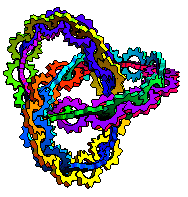|
|
|
The trefoil knot ,
also called the threefoil knot or overhand knot, is the unique prime
knot with three crossings. It is a (3, 2)-torus knot
and has braid word
. The trefoil and its mirror
image are not equivalent, as first proved by Dehn (1914). In other words, the
trefoil knot is not amphichiral. It is, however,
invertible, and has Arf
invariant 1.
Its laevo form is implemented in the Wolfram Language, as illustrated above, as KnotData["Trefoil"].
M. C. Escher's woodcut "Knots" (Bool et al. 1982, pp. 128 and 325; Forty 2003, Plate 71) depicts three trefoil knots composed of differing types of strands. A preliminary study (Bool et al. 1982, p. 123) depicts another trefoil.

The animation above shows a series of gears arranged along a Möbius strip trefoil knot (M. Trott).
The bracket polynomial can be computed as follows.
|
(1)
| |||
|
(2)
|
Plugging in
|
(3)
| |||
|
(4)
|
gives
|
(5)
|
The corresponding Kauffman polynomial X is then given by
|
(6)
| |||
|
(7)
|
where the writhe (Kauffman 1991, p. 35; Livingston 1993, p. 219)
The Alexander polynomial , BLM/Ho polynomial
, Conway
polynomial
,
HOMFLY polynomial
, Jones polynomial
, and Kauffman
polynomial F
of the trefoil knot are
|
(8)
| |||
|
(9)
| |||
|
(10)
| |||
|
(11)
| |||
|
(12)
| |||
|
(13)
|
Here,
corresponds to the right-hand trefoil.
There are no other knots on 10 or fewer crossings sharing the same Alexander polynomial, BLM/Ho polynomial, or Jones polynomial.
The knot group of the trefoil knot is
|
(14)
|
or equivalently
|
(15)
|
(Rolfsen 1976, pp. 52 and 61).